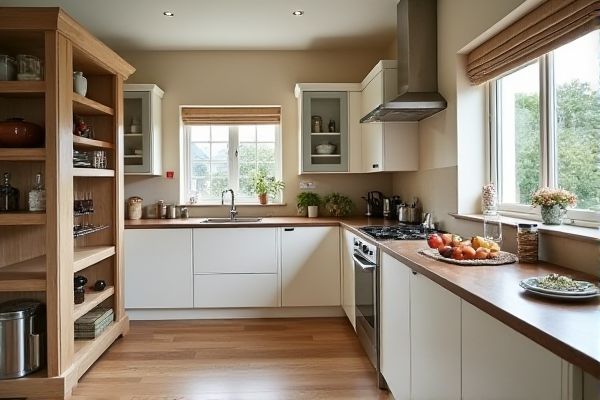
A Butler's pantry serves as a stylish storage and staging area for dining and entertaining, often integrated into the main kitchen space, while a scullery is a more utilitarian room dedicated to heavy-duty cleaning and food preparation tasks. Understanding the differences can help you design a more efficient and functional kitchen area--explore the rest of the article to choose the best option for your home.
Table of Comparison
| Feature | Butler's Pantry | Scullery |
|---|---|---|
| Primary Purpose | Storage and staging for dishes, glassware, and serving items | Heavy-duty food prep, cleaning, and dishwashing |
| Location | Adjacent to main kitchen and dining areas | Typically behind the kitchen, often hidden from guests |
| Design | Elegant, organized with cabinetry and countertops | Functional, durable surfaces and multiple sinks |
| Common Features | Wine storage, countertops, cabinetry, small appliances | Sinks, dishwashers, storage for cleaning supplies, prep areas |
| Usage | Staging and serving assistance during meals | Food washing, prep, heavy cleaning, and waste disposal |
| Historical Context | Originated in British estates for refined serving | Traditional kitchens designed for utility and hygiene |
Understanding the Butler’s Pantry
A Butler's pantry serves as a dedicated space for storage, food preparation, and staging meals, often situated between the kitchen and dining room to facilitate efficient service. This area typically includes cabinets, countertops, and sometimes a sink or small appliances, designed to keep your main kitchen clutter-free and organized. Unlike a scullery, which is primarily used for heavy cleaning and dishwashing, the Butler's pantry focuses on presentation and smooth meal transitions.
What is a Scullery?
A scullery is a secondary kitchen space originally designed for heavy-duty cleaning, food preparation, and dishwashing, often located adjacent to the main kitchen. Unlike a butler's pantry, which serves primarily as a storage and serving area for fine china and glassware, a scullery functions as a practical workspace to manage kitchen chores and maintain hygiene. In historical and luxury homes, sculleries help separate messy tasks from the main cooking and entertaining areas to streamline household operations.
Key Differences Between Butler’s Pantry and Scullery
Butler's pantries typically serve as elegant storage and staging areas for dining ware and fine china, enhancing organization and presentation in formal dining settings. Sculleries function as practical, utility-focused spaces designed for heavy-duty cleaning, food prep, and dishwashing, often featuring robust sinks and countertops. Understanding these key differences helps you optimize your kitchen's workflow by allocating specific tasks and storage needs between the two areas.
Historical Origins and Evolution
The Butler's pantry originated in 18th-century Europe as a space for storing and organizing fine china, glassware, and silverware, evolving into a transitional area between the kitchen and dining room for meal preparation and service. The scullery dates back to medieval times as a utilitarian room for washing dishes, vegetables, and laundry, often located adjacent to the kitchen to keep mess and odors separate. Over time, both spaces adapted to modern homes, with the Butler's pantry emphasizing elegance and storage, while the scullery retained its practical, work-oriented function.
Design and Layout Considerations
Butler's pantries typically feature open shelving, countertop space, and cabinetry designed for easy access and display, enhancing kitchen workflow with a focus on organization and aesthetics. Sculleries prioritize utility with deep sinks, dishwashers, and ample storage for cleaning supplies, often hidden from main kitchen areas to maintain neatness. Your choice between these depends on whether you prefer a visually appealing, semi-open space or a more practical, concealed area dedicated to chores.
Storage Solutions: Butler’s Pantry vs Scullery
A Butler's pantry offers elegant, accessible storage solutions designed for final meal prep and serving, featuring cabinetry and open shelving optimized for dinnerware, glassware, and serving pieces. In contrast, a scullery provides heavy-duty, practical storage for kitchen tools, bulk food items, and cleaning supplies, often including refrigeration and washing areas to keep clutter out of the main kitchen. Your choice between these spaces depends on whether you need refined presentation storage or robust utility storage to streamline kitchen workflow.
Functional Uses in Modern Homes
Butler's pantries serve as elegant storage and staging areas for dishware and glassware, enhancing formal dining experiences, while sculleries focus on heavy-duty cleaning, food prep, and dishwashing tasks, often equipped with utility sinks and durable surfaces. In modern homes, your butler's pantry complements kitchen organization by keeping countertops clutter-free during entertaining, whereas the scullery acts as a hidden workspace that streamlines kitchen workflow and reduces noise. Both spaces optimize functionality but differ in their roles--one prioritizes presentation, the other efficiency.
Aesthetic and Style Comparison
A Butler's pantry often features elegant cabinetry, glass-front cupboards, and polished countertops that create a refined, stylish aesthetic appealing to traditional or transitional home designs. In contrast, a scullery is designed with a more utilitarian style, prioritizing functionality and durability, typically showcasing stainless steel surfaces, open shelving, and robust materials suitable for heavy-duty cleaning and food preparation. Your choice between the two should consider whether you prefer a visually polished space for display and serving or a practical, work-focused room hidden from the main kitchen area.
Pros and Cons of Each Space
A Butler's pantry offers elegant storage and staging space, ideal for entertaining but can take up valuable square footage in smaller homes. A scullery provides a practical, hidden area for heavy-duty cleaning and food prep, reducing kitchen clutter but may lack the aesthetic appeal found in Butler's pantries. You should weigh your lifestyle needs and available space to decide which option enhances your home's functionality best.
Which is Right for Your Home?
A Butler's pantry offers an elegant, multifunctional space for storing fine china and preparing beverages, enhancing entertaining capabilities without cluttering your main kitchen. A scullery serves as a practical, heavy-duty area for cleaning, dishwashing, and managing kitchen messes, ideal for larger households or those who cook frequently. Your choice depends on whether you prioritize style and display or functionality and kitchen workflow efficiency.
 homyna.com
homyna.com